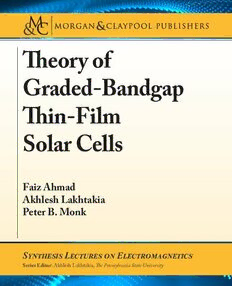
Theory of Graded-Bandgap Thin-Film Solar Cells PDF
Preview Theory of Graded-Bandgap Thin-Film Solar Cells
A H M Synthesis Lectures on Electromagnetics A D • E T A L Series Editor: Akhlesh Lakhtakia, The Pennsylvania State University Theory of Theory of Graded-Bandgap Thin-Film Solar Cells Faiz Ahmad, COMSATS University Islamabad Akhlesh Lakhtakia, The Pennsylvania State University T H Peter B. Monk, University of Delaware E Graded-Bandgap O R Y Thin-film solar cells are cheap and easy to manufacture but require improvements as their O F efficiencies are low compared to that of the commercially dominant crystalline-silicon solar cells. G R An optoelectronic model is formulated and implemented along with the differential evolution A D Thin-Film algorithm to assess the efficacy of grading the bandgap of the CIGS, CZTSSe, and AlGaAs photon- E D absorbing layer for optimizing the power-conversion efficiency of thin-film CIGS, CZTSSe, and -B A AlGaAs solar cells, respectively, in the two-terminal single-junction format. Each thin-film solar N D cell is modeled as a photonic device as well as an electronic device. Solar cells with two (or more) G A Solar Cells photon-absorbing layers can also be handled using the optolelectronic model, whose results will P T stimulate experimental techniques for bandgap grading to enable ubiquitous small-scale harnessing H I of solar energy. N - F I L M S O L A R C Faiz Ahmad E L L S Akhlesh Lakhtakia ABOUT SYNTHESIS This volume is a printed version of a work that appears in the Synthesis Peter B. Monk Digital Library of Engineering and Computer Science. Synthesis lectures provide concise original presentations of important research and development topics, published quickly in digital and print formats. For M more information, visit our website: http://store.morganclaypool.com O R G A N & Synthesis Lectures on Electromagnetics C L A Y Series Editor: Akhlesh Lakhtakia, The Pennsylvania State University store.morganclaypool.com P O O L Theory of Graded-Bandgap Thin-Film Solar Cells Synthesis Lectures on Electromagnetics Editor AkhleshLakhtakia,ThePennsylvaniaStateUniversity TheoryofGraded-BandgapThin-FilmSolarCells FaizAhmad,AkhleshLakhtakia,andPeterB.Monk 2021 SpoofPlasmons TatjanaGric 2020 TheTransfer-MatrixMethodinElectromagneticsandOptics TomG.MackayandAkhleshLakhtakia 2020 Copyright©2021byMorgan&Claypool Allrightsreserved.Nopartofthispublicationmaybereproduced,storedinaretrievalsystem,ortransmittedin anyformorbyanymeans—electronic,mechanical,photocopy,recording,oranyotherexceptforbriefquotations inprintedreviews,withoutthepriorpermissionofthepublisher. TheoryofGraded-BandgapThin-FilmSolarCells FaizAhmad,AkhleshLakhtakia,andPeterB.Monk www.morganclaypool.com ISBN:9781636392165 paperback ISBN:9781636392172 ebook ISBN:9781636392189 hardcover DOI10.2200/S01119ED1V01Y202107EMA003 APublicationintheMorgan&ClaypoolPublishersseries SYNTHESISLECTURESONELECTROMAGNETICS Lecture3 SeriesEditor:AkhleshLakhtakia,ThePennsylvaniaStateUniversity SeriesISSN ISSNpending. Theory of Graded-Bandgap Thin-Film Solar Cells Faiz Ahmad COMSATSUniversityIslamabad Akhlesh Lakhtakia ThePennsylvaniaStateUniversity Peter B. Monk UniversityofDelaware SYNTHESISLECTURESONELECTROMAGNETICS3 M &C Morgan &cLaypool publishers ABSTRACT Thin-filmsolarcellsarecheapandeasytomanufacturebutrequireimprovementsastheireffi- cienciesarelowcomparedtothatofthecommerciallydominantcrystalline-siliconsolarcells.An optoelectronicmodelisformulatedandimplementedalongwiththedifferentialevolutionalgo- rithmtoassesstheefficacyofgradingthebandgapoftheCIGS,CZTSSe,andAlGaAsphoton- absorbing layer for optimizing the power-conversion efficiency of thin-film CIGS, CZTSSe, and AlGaAs solar cells, respectively, in the two-terminal single-junction format. Each thin- film solar cell is modeled as a photonic device as well as an electronic device. Solar cells with two (or more) photon-absorbing layers can also be handled using the optolelectronic model, whoseresultswillstimulateexperimentaltechniquesforbandgapgradingtoenableubiquitous small-scaleharnessingofsolarenergy. KEYWORDS AlGaAs, bandgap grading, CIGS, CZTSSe, differential evolution algorithm, double-absorbersolarcell,optoelectronicoptimization,thin-filmsolarcell vii Dedicated to the future availability of inexpensive energy on a pollution-free planet
